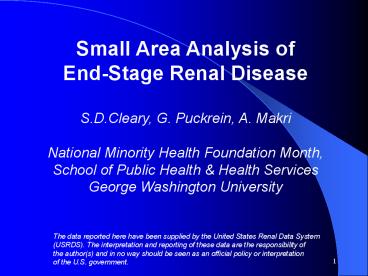Small Area Analysis of PowerPoint PPT Presentation
1 / 25
Title: Small Area Analysis of
1
Small Area Analysis of End-Stage Renal
Disease S.D.Cleary, G. Puckrein, A.
Makri National Minority Health Foundation
Month, School of Public Health Health
Services George Washington University
The data reported here have been supplied by the
United States Renal Data System (USRDS). The
interpretation and reporting of these data are
the responsibility of the author(s) and in no
way should be seen as an official policy or
interpretation of the U.S. government.
2
Background
- ESRD Severe chronic kidney disease
- A complete/near complete failure of day-to-day
function - Follows chronic kidney failure, with 10-20 year
latency - Primary risk factors diabetes, hypertension
- U.S. incidence rates increasing since 1980
- Costs increasing, large part of Medicare costs
- 18,000 - 59,000 per patient-year
- care costs for all patients 12 billion in
2000 (USRDS 2002)
3
Disproportionate Burdenon Minorities
- Greater annual incidence, prevalence, YLLs
- Treated ESRD incidence and prevalence 3-4
higher for Blacks and Native Americans than
Whites. - Blacks 12 of population, 32 of prevalent ESRD
pop. (2000) - ESRD lost life years for black women, similar
to breast cancer for black men, more than
colorectal or prostate cancer. - Disease develops at an earlier age
- Lower health care quality and/or access
4
Reasons for Disparity?
- Incomplete understanding -- interplay of
genetic, cultural, environmental, social factors - Documented disparities in health care delivery,
intermediate outcomes, interventions -- decreased
provision of renal replacement therapy, dialysis - Explaining part of the Black-White disparity
- Higher prevalence of hypertension diabetes
- Enhanced susceptibility to organ damage
- Inadequate access to therapy and interventions
5
ESRD Project
- Description and mapping of ESRD incidence in
small geographic areas (zip codes) across the
U.S. population - Hypotheses
- ESRD incidence is higher in racial minority areas
vs. non-minority areas - Variable incidence within minority population
areas
6
Methods Data Sources
- ESRD cases (numerator)
- Source U.S. Renal Data System USRDS
- Demographic and treatment-related information
per patient - U.S. population (denominator)
- Source U.S. Census Bureau (2000)
- Demographics by Zip Code
- Geographic subdivisions (spatial display)
- Source U.S. Census Bureau
- Various geographic resolutions zip code,
county, state
7
Methods Definitions
- Case definition (by USRDS)
- ESRD patient an individual "who has developed
chronic renal failure and requires kidney
replacement treatment - dialysis or transplant -
to sustain life. - Disease certified by physician or other evidence
of treatment - Cases excluded if treatment led to recovery,
included if death - Incident cases (in this study)
- Record of first treatment between 1992 and 2001
8
Analysis Calculations
- Annual age-adjusted incidence rates
- By zip code
- Exclude zip codes with population
- To make comparisons across zip codes, the DIRECT
STANDARDIZATION METHOD was utilized to adjust for
different underlying age distributions - Minority zip code
- a zip code in which 50 or more of the
population is African American, Native American,
Hispanic, Asian or Pacific Islander
9
Analysis Geographic Display
- Maps of incidence rates
- Unique color assigned to benchmark values across
areas (vs. point location) - Incidence rates overlaid with minority status,
by zip code (software ArcMap 8.2)
10
Results
- Sufficient data available for 8,171 zip codes
representing 80 of the ESRD cases during the
study period. - National mean annual age-adjusted incidence rate
31/100,000 population - Non-minority (n6,032) zip codes 24/100,000 popn
- Minority (n2,139) zip codes 51/100,000 popn
- National 33.3/100,000 (USRDS, 2002)
11
Maps of ESRD Incidence Rates (age-adjusted per
100,000 population)
Green - zip codes less than National mean of
31 Yellow - zip codes between National and
Minority means 31.1-51.0 Red - zip codes above
Minority mean of 51.0 Hollow zip codes with
insufficient data
12
(No Transcript)
13
(No Transcript)
14
(No Transcript)
15
(No Transcript)
16
(No Transcript)
17
(No Transcript)
18
(No Transcript)
19
Conclusions
- Level of risk related to racial minority status
- High level ? minority zip codes -- Low level ?
non-minority - Trend is consistent across zip codes with
varying minority population - Clear spatial demarcation of areas with high vs.
low incidence - ESRD incidence higher in racial minority vs.
non-minority areas
20
Conclusions
- ESRD incidence varies within minority areas
- Variable risk within minority zip codes
- Incidence rates have wide range difference of
11- 463 per 100,000 population - Suggestive of variation within this group in risk
and sociodemographic factors, access to care
21
Explaining regional ESRD variation
Health care differences between minority and
non-minority groups may account for a substantial
portion of the geographic variation in ESRD
incidence and minority status
22
(No Transcript)
23
(No Transcript)
24
Limitations Potential Biases
- USRDS database
- 1996 changes in patient eligibility and data
collection procedures -- pool of cases eligible,
diagnosis, information completeness - Potential biases
- 2000 data extrapolated to 1992-2001 for rates
- Definition of minority based on arbitrary
benchmark -- includes many subgroups that differ
in burden and risk factors - due to small sample at zip code level, 20
cases excluded from analysis
25
Further Research Applications
- Research
- Identify factors that explain ESRD variation and
discriminate low-risk from high-risk minority
areas - Use different definition of minority
(distribution, composition) - Further explore spatial variation in incidence,
minority status, other factors (sociodemographics,
hospital/provider density) - Applications in public health
- Target prevention and allocate resources
efficiently at local level - Value of small area geographic analysis for
research and practice

